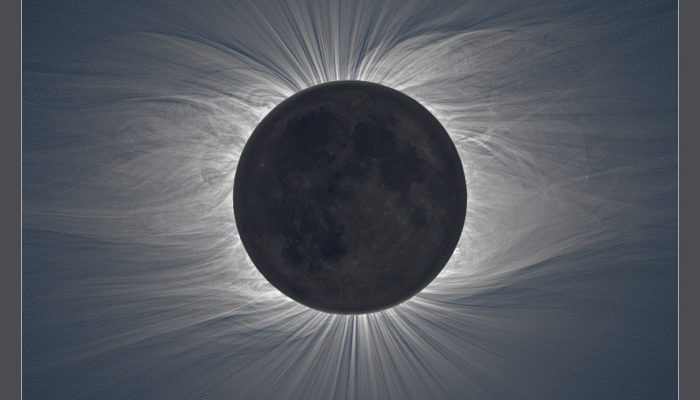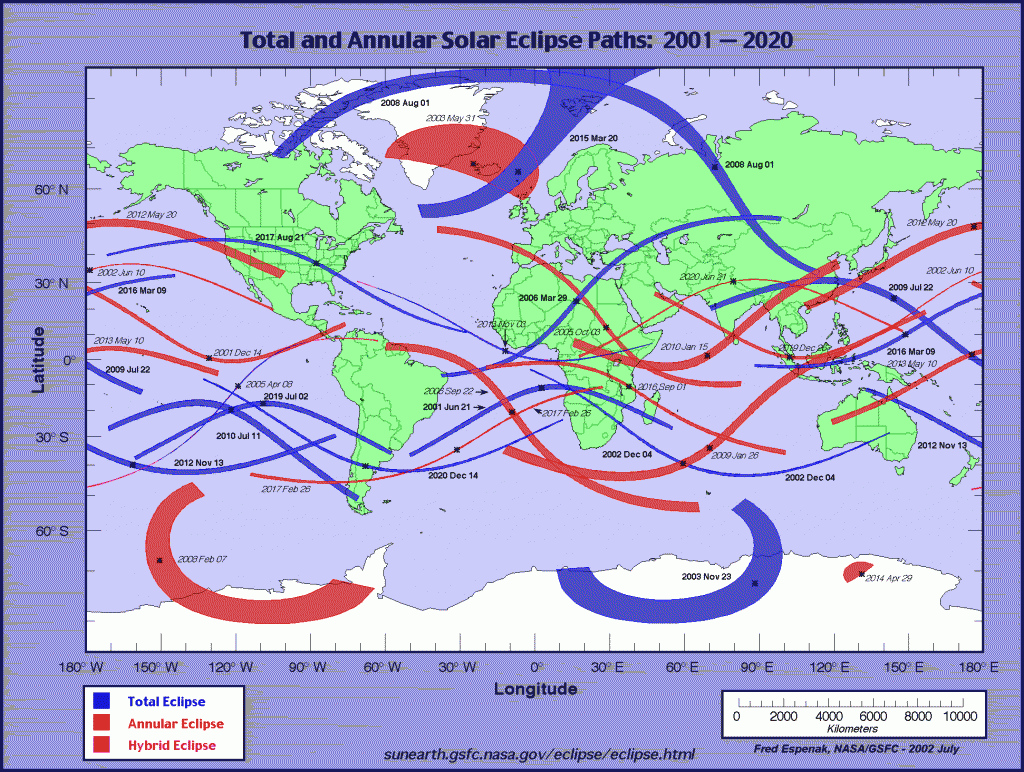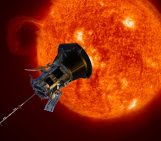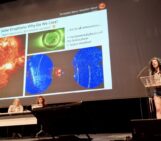
The next solar eclipse is upon us. On August 21 the moon will pass between the Sun and an observer’s point of view in America and block out daylight, creating an eerie gloom in the sky. The transit of the moon between the Earth and Sun occurs about every 18 months, but for your particular city it can take several hundreds of years before a new eclipse occurs. The figure below shows the paths of all solar eclipses that occurred or will occur during the 2001 to 2020 period. Few eclipses happen around the North or South pole due to the orbital geometry of the heavenly bodies, so proportionally the odds are higher to experience midday darkness if you live at low or mid latitudes. However, since about 71% of the Earth’s surface is covered with water, most of these eclipses occur at places where no one lives and go by unnoticed. Unless you travel to them!
People have long been fascinated by solar eclipses and records in history have been found as early as 2000 B.C. Throughout history researchers and science enthousiasts have travelled the world to watch eclipses, endeavours which were much more difficult in the early days than with nowadays commercial flights. Maybe you are travelling as well to watch this eclipse.

Paths of total and annular solar eclipses during the 2001-2020 period. Credit: Fred Espenak, NASA/GSFC Emeritus
By studying the sun and the eclipses, scientists can look at features of the solar atmosphere that are otherwise hard to observe from the ground due to the intense brightness of the Sun. Discoveries made during eclipses include observations of the outer parts of the solar atmosphere (solar corona), flames of fire from the sun (prominences, jets), radiation other than visible light (infrared, UV) and otherwise invisible comets travelling around the Sun. During the 1868 eclipse a yellow spectral line was discovered by J. Lockyer in the solar chromosphere from a yet unknown chemical element that turned out to be one of the most abundant chemical species in our universe. He named it after the Greek word for the sun (helios) and it took until 1895 before helium was discovered on Earth.
Even today, scientific knowledge is being advanced by studying the solar eclipse and the effects on our nearby space environment and Earth’s atmosphere. When the moon eclipses the Sun, the illumination over a localised region will change rapidly and Earth’s atmosphere will react to this decrease in solar energy. One such reaction that occurs is in the ionosphere, the higher most reaches of the atmosphere. Solar ultraviolet radiation creates a dynamic layer of charged particles that reflect telecommunication transmissions at very low frequencies around the world. Understanding how this layer reacts to changes in solar radiation can enhance our understanding of the ionosphere and hopefully improve the region’s dynamics in model simulations. The direct blocking of radiation will also have a profound effect on the total amount of radiation that is received by the surface as well on the amount that is reflected back to space by the oceans, clouds and atmosphere. Changes in this radiation budget can in a unique way be investigated during the solar eclipse. Studying these variations, in for example temperature or radiation, during an eclipse are useful to test our current understanding of the Sun’s effect on the atmosphere.
Not only academics, but also citizens can contribute to advances in solar-terrestrial science. The Megamovie project aims to create an open-source archive of nearly 1.5 hours continuous solar eclipse. With this dataset new features in the solar corona on long and short time scales will hopefully be discovered.
So, what will you do on 21 August 2017? Watching the eclipse from your hometown, travelling to the path of totality from across the world or take part in any scientific contribution as citizen or researcher? Hopefully you will enjoy the magical moment and experience something new!
For more information:
http://www.mreclipse.com/Totality2/TotalityApH.html




